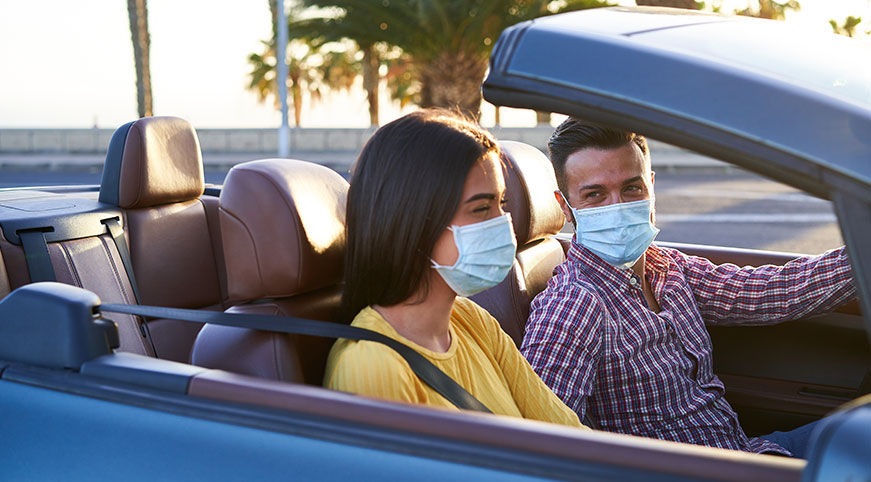Posted by Dr. Thomas Horowitz
As lockdown orders are gradually relaxed across the nation and around the world, people are making travel plans for summer and are thinking about taking that vacation they put off because of COVID-19. The COVID-19 pandemic is constantly evolving and it is difficult to completely protect yourself from the risk of infection.
Traveling a short distance with your family in your own vehicle is safer than using public transportation. For long distance travel, you may need to decide if it is safer to fly or drive.
Car travel
Traveling by car gives you control over the density of passengers (number of people who travel with you) and your environment. However, you need to plan your trip in advance to decide your pit stop for eating, sleeping, and using the restroom.
- Wear a face mask when you stop at a restaurant, gas station, or use a public restroom to ensure your safety.
- Take rest stops in non-crowded areas and, if possible, make fewer stops to avoid coming in contact with other people. Try to use restrooms that are less crowded and remember, flushing can aerosolize germs and viruses. It is important to be vigilant and careful wherever you are.
- Carry antibacterial wipes and hand sanitizer (containing at least 60% alcohol) to use during the journey. Whenever possible, wash your hands with soap and water for at least 20 seconds after you visit public places like restrooms, restaurants, gas stations, after coughing or sneezing, or before eating.
- Consider buying drive-thru meals rather than stopping for indoor dining as this would reduce contact with others. If possible, pack enough meals and water for the journey and avoid stopping at a restaurant.
Air travel
When traveling by air, you cannot control the number of people traveling with you and it is impractical to have empty seats next to you to ensure appropriate social distancing in a plane. Moreover, you may spend ample time in security check and airport terminals, which may bring you in close contact with people and frequently touched surfaces.
- Even though the air in planes is filtered, which helps ensure that the virus and germs do not spread easily, it is important to wear a mask at all times and in the appropriate manner. Wearing a mask under your nose is of little value and offers no protection from COVID-19. Make sure that your mask fits well and offers good protection. If possible, consider wearing a face shield as well. Politely encourage those around you to keep their mask on for everyone’s safety.
- Remember to carry antibacterial wipes with you and wipe all frequently touched surfaces around you.
- If you are flying a short distance, try to avoid having meals onboard as you cannot eat with a mask on. Removing the mask will put you and those around you at risk for COVID-19.
- When using the restroom, let the restroom air out for some time before using it.
- Wash your hands with soap and water for at least 20 seconds, especially after you use the restroom or after touching surfaces frequently touched by others, after blowing your nose, coughing, or sneezing, and before touching your face or eating. If soap and water are not available, use a hand sanitizer that contains at least 60% alcohol.
Universal precautions for COVID-19, whether you drive or fly
Whether you decide to travel by car or plane, both modes of transportation require caution. You must weigh the risk of being in an enclosed environment, for long hours, with other people in the plane versus the multiple venues that you may encounter over long hours or days on the road. In both cases, you can reduce the risk of COVID-19 by doing the following:
- Wear a cloth face covering or face mask—that fits well—whenever you are in a crowded place or in the same room with other people. Avoid touching your face, eyes, nose or mouth.
- Carry a hand sanitizer (with at least 60% alcohol) and antibacterial wipes to clean frequently touched surfaces near you.
- Wash your hands with soap and water for at least 20 seconds before eating or whenever you cough, sneeze, or touch a public surface.
- Practice social distancing; maintain a separation of at least six feet from others.
- Cover your coughs and sneezes.
If you decide to travel, follow all precautions and safety measures to protect yourself and others.
Go to our Blog
 ENGLISH
ENGLISH KOREAN
KOREAN Spanish
Spanish RUSSIAN
RUSSIAN Armenian
Armenian FILIPINO
FILIPINO Chinese (Simplified)
Chinese (Simplified) Chinese (Traditional)
Chinese (Traditional)


최신댓글